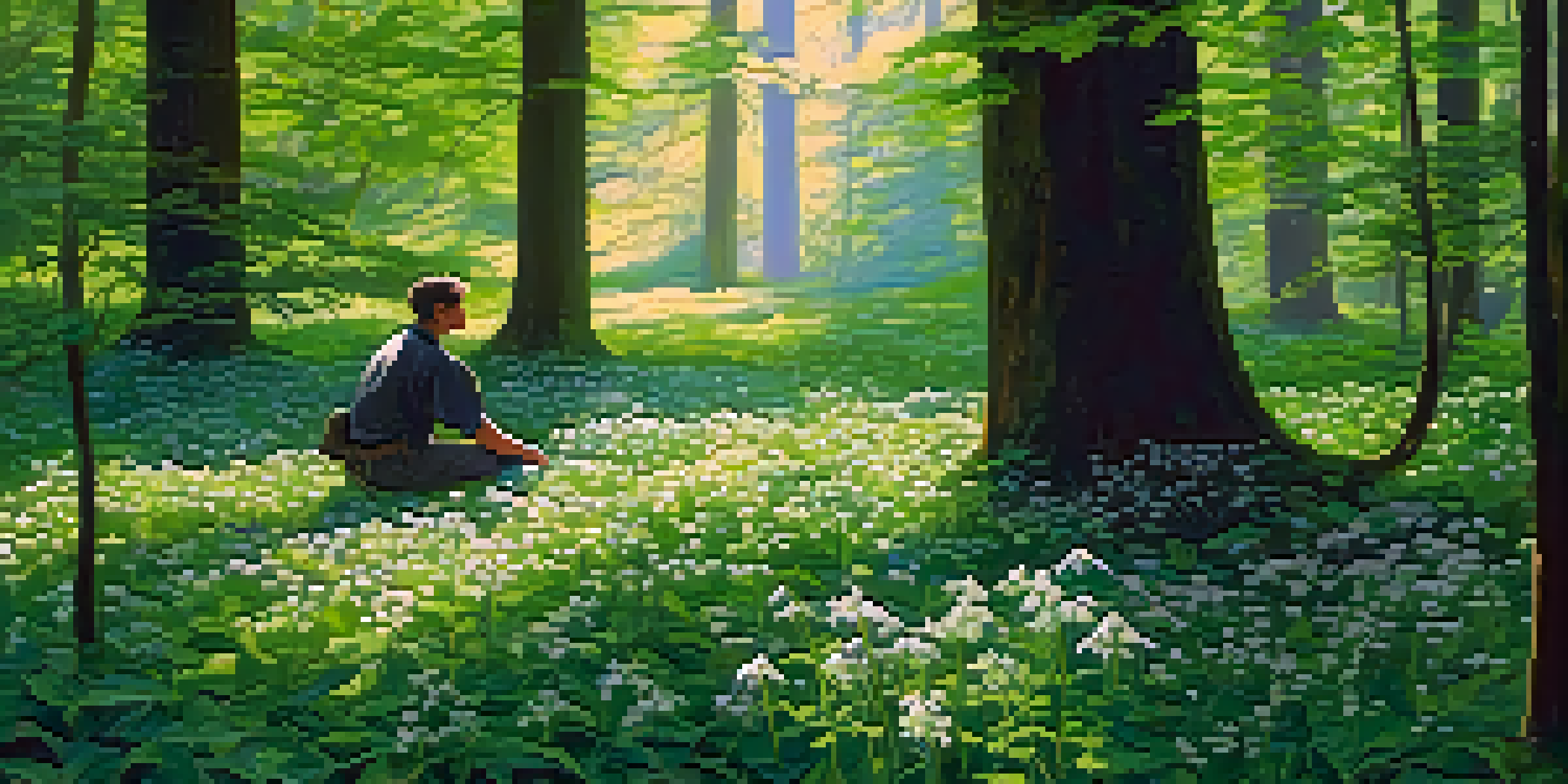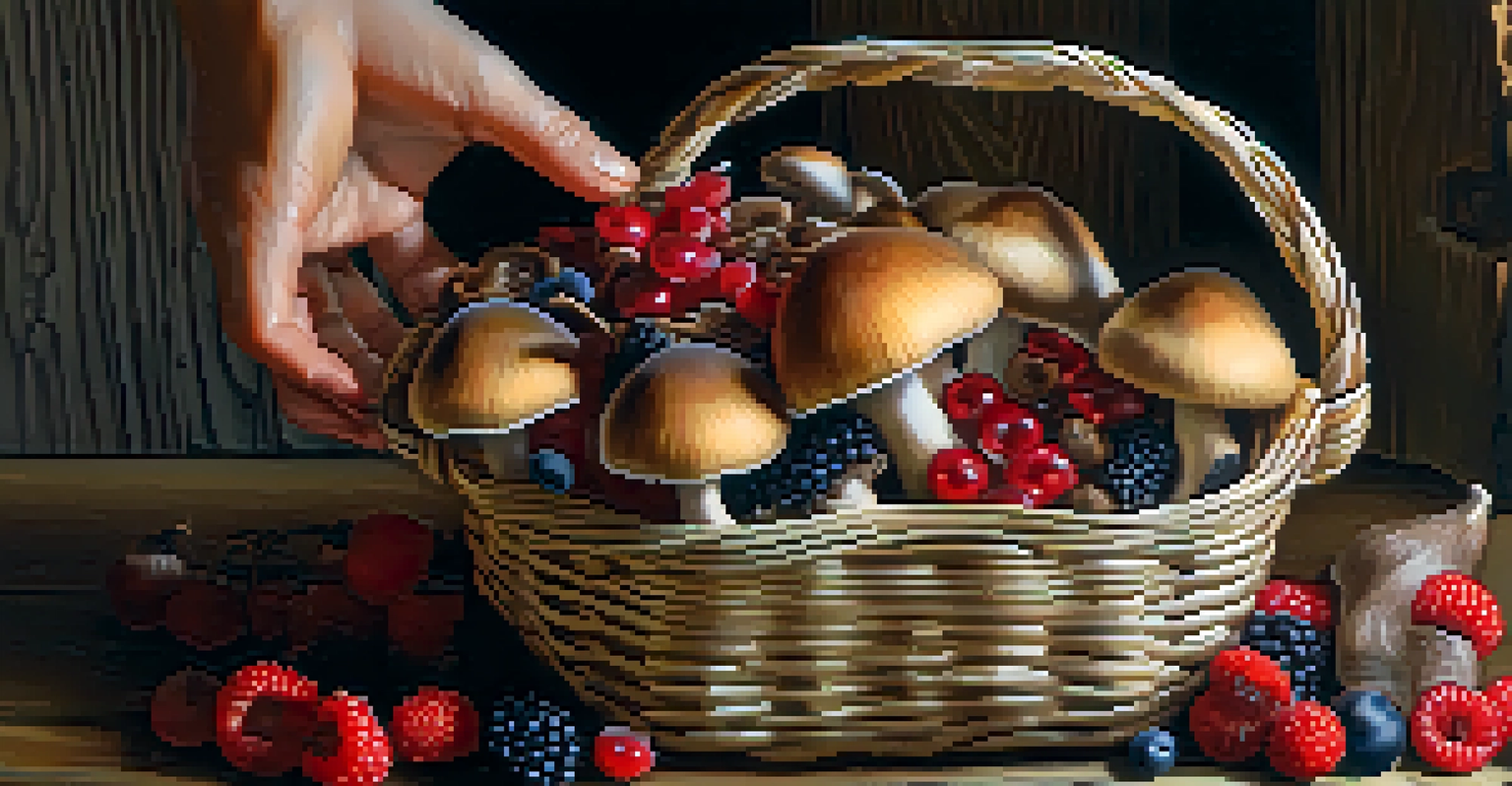Understanding Wild Harvesting: Techniques for Sustainable Foraging

What is Wild Harvesting and Why It Matters
Wild harvesting, also known as foraging, involves collecting edible plants, mushrooms, and other natural resources from their native environments. It’s a practice that connects us with nature and offers a sustainable way to source food. By understanding what can be foraged, we can reduce our reliance on commercially grown products.
Foraging is not just a way to find food; it's a way to connect with nature and appreciate the world around us.
However, wild harvesting isn’t just about food; it also plays a crucial role in preserving biodiversity. When done responsibly, it can help maintain healthy ecosystems by controlling invasive species and promoting native plant growth. This kind of balance is essential for our planet’s health.
Moreover, wild harvesting fosters a deeper appreciation for the environment. It encourages individuals to learn about local flora and fauna, which can lead to more sustainable choices in other areas of life. In essence, it’s not just about gathering; it’s about engaging with nature.
Essential Techniques for Sustainable Foraging
Sustainable foraging begins with knowledge and preparation. Familiarizing yourself with local plants and their seasons is crucial. This means doing your homework—researching which species are edible and when they are at their peak. For example, wild garlic is best harvested in spring, while berries are typically ready in late summer.

Another key technique is the 'one-for-you, one-for-me' rule, where foragers take only what they need and leave enough for wildlife and the plant population to thrive. This method ensures that your actions positively impact the environment. Think of it as sharing a meal; there's enough for everyone if we all act responsibly.
Wild Harvesting Benefits Nature
Wild harvesting not only provides sustainable food options but also helps preserve biodiversity and healthy ecosystems.
Additionally, using proper tools can enhance your foraging experience. A small knife, a basket for collection, and a field guide can make all the difference. These tools not only help in identifying and collecting plants but also ensure that you do so in a way that minimizes damage to the ecosystems you explore.
Safety First: Identifying Edible vs. Toxic Plants
When foraging, knowing the difference between edible and toxic plants is paramount. Some plants have poisonous look-alikes, making proper identification essential. For instance, the edible wild carrot resembles the toxic hemlock, and mistaking one for the other can have serious consequences.
The greatest gift of the garden is the restoration of the five senses.
To avoid such pitfalls, it’s advisable to forage with an experienced guide or take classes in plant identification. Many local communities offer workshops that not only teach you what to look for but also how to assess the safety of what you find. This is a great way to learn from others and build confidence.
Always remember, when in doubt, it’s best to leave it out. If you’re unsure about a plant's edibility, don’t take the risk. Safety should always be your top priority when exploring nature’s bounty.
Ethical Foraging: Respecting Nature and Local Laws
Ethical foraging goes hand-in-hand with sustainability, emphasizing the need to respect nature and abide by local laws. Many areas have regulations regarding what can be harvested and in what quantities. These rules are in place to protect ecosystems and ensure that wild plants can regenerate.
Moreover, foragers should always seek permission when harvesting on private land. It’s about building a respectful relationship with landowners and understanding the importance of stewardship. Just like any good neighbor, being courteous can lead to mutual benefits.
Safety is Crucial in Foraging
Identifying edible plants accurately is essential, as some can be toxic, highlighting the importance of education and caution.
Lastly, consider the impact of your foraging activities on wildlife. Avoid nesting areas and refrain from harvesting rare plants. By being considerate of the broader ecosystem, you contribute to the health of the environment, ensuring that future generations can enjoy the same foraging opportunities.
Adapting Foraging Practices to Different Environments
Foraging can vary significantly based on your environment, whether it’s a forest, coastal area, or urban setting. Each habitat has its unique offerings, and understanding these can enhance your foraging experience. For example, coastal foraging may yield seaweed and shellfish, while forests offer mushrooms and wild berries.
Adapting your foraging techniques to your environment is essential. In urban settings, you might find edible weeds in local parks or even on sidewalks. These resilient plants can often provide surprising culinary delights. Think of dandelions, which are not only common but also packed with nutrients.
Ultimately, the key is to observe and learn from your surroundings. Nature has a way of providing if you’re willing to explore and adapt. Each new environment presents a fresh adventure, and the more you learn, the more you can enjoy the diversity of nature's offerings.
The Role of Foraging in Food Security
Foraging can enhance food security by providing access to nutritious, local food sources. In times of economic uncertainty or food scarcity, knowledge of wild harvesting can be a valuable skill. Imagine being able to supplement your groceries with wild greens or mushrooms from your local woods.
Furthermore, foraging promotes self-sufficiency and resilience. By learning to identify edible plants, individuals and communities can reduce their dependence on commercial food systems. This not only saves money but also encourages a healthier, more sustainable lifestyle.
Foraging Supports Food Security
Foraging enhances food security by providing access to nutritious local food sources, promoting self-sufficiency and resilience.
Incorporating foraging into your diet can also lead to a deeper connection with food. Understanding where your meals come from fosters gratitude and respect for the environment. It’s a reminder that food is not just a product but part of a complex ecosystem.
Tips for Getting Started with Foraging
If you’re new to foraging, starting small is key. Begin by exploring your backyard or a nearby park to familiarize yourself with common edible plants. This way, you can build your confidence without venturing too far from home. One of the easiest plants to identify is the clover, which can be eaten raw or brewed into tea.
Joining a local foraging group or community can provide invaluable support and information. These groups often organize foraging walks, where experienced foragers share their knowledge. It’s a great opportunity to learn, meet like-minded individuals, and share your experiences.

Lastly, always keep a foraging journal. Documenting your finds, recipes, and experiences can help you track your progress and enhance your learning. Plus, it’s a fun way to reflect on your adventures in nature and the unique bounty it offers.